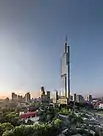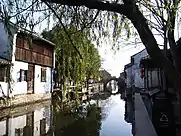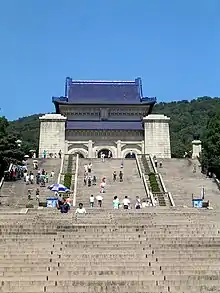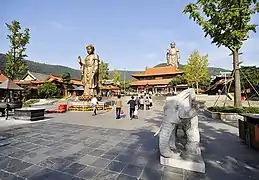Jiangsu
Jiangsu (UK: /dʒæŋˈsuː/;[4] US: /ˈdʒjɑːŋˈsuː/ [5] Chinese: ![]() 江苏; pinyin: Jiāngsū, formerly romanized Kiangsu) is an eastern coastal province of the People's Republic of China. It is one of the leading provinces in finance, education, technology, and tourism, with its capital in Nanjing. Jiangsu is the third smallest, but the fifth most populous and the most densely populated of the 23 provinces of the People's Republic of China. Jiangsu has the highest GDP per capita of Chinese provinces and second-highest GDP of Chinese provinces, after Guangdong.[6] Jiangsu borders Shandong in the north, Anhui to the west, and Zhejiang and Shanghai to the south. Jiangsu has a coastline of over 1,000 kilometres (620 mi) along the Yellow Sea, and the Yangtze River passes through the southern part of the province.
江苏; pinyin: Jiāngsū, formerly romanized Kiangsu) is an eastern coastal province of the People's Republic of China. It is one of the leading provinces in finance, education, technology, and tourism, with its capital in Nanjing. Jiangsu is the third smallest, but the fifth most populous and the most densely populated of the 23 provinces of the People's Republic of China. Jiangsu has the highest GDP per capita of Chinese provinces and second-highest GDP of Chinese provinces, after Guangdong.[6] Jiangsu borders Shandong in the north, Anhui to the west, and Zhejiang and Shanghai to the south. Jiangsu has a coastline of over 1,000 kilometres (620 mi) along the Yellow Sea, and the Yangtze River passes through the southern part of the province.
Jiangsu
江苏 | |
|---|---|
| Name transcription(s) | |
| • Chinese | 江苏省 (Jiāngsū Shěng) |
| • Abbreviation | JS / 苏 (pinyin: Sū) |
| • Wu | Kaonsu San |
| • Jiang–Huai | Jiang1 su1 Sen3 |
.svg.png.webp) Map showing the location of Jiangsu Province | |
| Coordinates: 32°54′N 119°48′E | |
| Country | China |
| Named for | 江 Jiāng – Jiangning (now Nanjing) 苏 sū – Suzhou |
| Capital | Nanjing |
| Largest city | Suzhou |
| Divisions | 13 prefectures, 106 counties, 1488 townships |
| Government | |
| • Type | Province |
| • Body | Jiangsu Provincial People's Congress |
| • CCP Secretary | Wu Zhenglong |
| • Congress chairman | Wu Zhenglong |
| • Governor | Xu Kunlin |
| • CPPCC chairman | Zhang Yizhen |
| • National People's Congress Representation | 149 deputies |
| Area | |
| • Total | 102,600 km2 (39,600 sq mi) |
| • Rank | 25th |
| Highest elevation (Mount Huaguo) | 625 m (2,051 ft) |
| Population (2020)[1] | |
| • Total | 84,748,016 |
| • Rank | 5th |
| • Density | 830/km2 (2,100/sq mi) |
| • Rank | 4th |
| Demographics | |
| • Ethnic composition | Han – 99.6% Hui – 0.2% (160,800) |
| • Languages and dialects | Mandarin (Official) Jianghuai Mandarin, Wu, Zhongyuan Mandarin |
| ISO 3166 code | CN-JS |
| GDP (2021) | CNY 11.64 trillion USD 1.805 trillion [2] |
| - per capita | CNY 137,348 USD 21,294 (3rd) |
| • growth | |
| HDI (2019) | 0.803[3] (very high) (4th) |
| Website | www |
| Jiangsu | |||||||||||||||||||||||||||||||
|---|---|---|---|---|---|---|---|---|---|---|---|---|---|---|---|---|---|---|---|---|---|---|---|---|---|---|---|---|---|---|---|
.svg.png.webp) "Jiangsu" in Simplified (top) and Traditional (bottom) Chinese characters | |||||||||||||||||||||||||||||||
| Simplified Chinese | 江苏 | ||||||||||||||||||||||||||||||
| Traditional Chinese | 江蘇 | ||||||||||||||||||||||||||||||
| Postal | Kiangsu | ||||||||||||||||||||||||||||||
| Literal meaning | "Jiang(ning) and Su(zhou)" | ||||||||||||||||||||||||||||||
| |||||||||||||||||||||||||||||||
Since the Sui and Tang dynasties, Jiangsu has been a national economic and commercial center, partly due to the construction of the Grand Canal. Cities such as Nanjing, Suzhou, Wuxi, Changzhou, and Shanghai (separated from Jiangsu in 1927) are all major Chinese economic hubs. Since the initiation of economic reforms in 1990, Jiangsu has become a focal point for economic development. It is widely regarded as one of China's most developed provinces, when measured by its Human Development Index (HDI).[3] Its 2021 nominal GDP per capita reached RMB 137,300 (US$21,287), becoming the first province in China to reach $20,000 mark.[7]
Jiangsu is home to many of the world's leading exporters of electronic equipment, chemicals and textiles.[8] It has also been China's largest recipient of foreign direct investment since 2006. Its 2021 nominal GDP was more than RMB 11.64 trillion (US$1.80 trillion), which is the fifth-highest of all country subdivisions.[7] If it were a country, it would be the tenth-largest economy as of 2021 as well as the 19th most populous.[9]
Jiangsu is also one of the leading provinces in research and education in China. As of 2022, Jiangsu hosts 168 institutions of higher education, ranking first of all Chinese provinces.[10] Jiangsu has many highly ranked educational institutions,[11] with 16 number of universities listed in the Double First-Class Universities, ranking second after Beijing. As of 2020, two major cities in Jiangsu ranked in the world's top 50 (Nanjing 8th and Suzhou 45th) cities by scientific research output, as tracked by the Nature Index.[12]
Name
Jiangsu's name is a compound of the first elements of the names of the two cities of Jiangning (now Nanjing) and Suzhou. The abbreviation for this province is "苏" (Sū), the second character of its name.[13]
History
During the earliest Chinese dynasties, the area that is now Jiangsu was far away from the center of Chinese civilization, which was in the northwest Henan; it was home of the Huai Yi (淮夷), an ancient ethnic group. During the Zhou dynasty more contact was made, and eventually the state of Wu appeared in southern Jiangsu, one of the many hundreds of states that existed across northern and central China at that time. Near the end of the Spring and Autumn period, Wu became a great power under King Helu of Wu, and defeated in 484 BC the state of Qi, a major power in the north in modern-day Shandong province, and contest for the position of overlord over all states of China. The state of Wu was subjugated in 473 BC by the state of Yue, another state that had emerged to the south in modern-day Zhejiang province. Yue was in turn subjugated by the powerful state of Chu from the west in 333 BC. Eventually the state of Qin swept away all the other states, and unified China in 221 BC.[14]

Under the reign of the Han dynasty (206 BC to 220 AD), Jiangsu was removed from the centers of civilization in the North China Plain, and was administered under two zhou (provinces): Xu Province in the north, and Yang Province in the south. During the Three Kingdoms period, southern Jiangsu became the base of the Eastern Wu (222 to 280), whose capital, Jianye (later renamed to Jiankang), is modern Nanjing. When nomadic invasions overran northern China in the 4th century, the imperial court of the Jin dynasty moved to Jiankang. Cities in southern and central Jiangsu swelled with the influx of migrants from the north. Jiankang remained as the capital for four successive Southern dynasties and became the largest commercial and cultural center in China.[15]
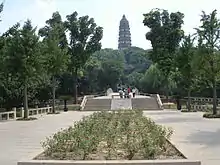
After the Sui dynasty united the country in 581, the political center of the country shifted back to the north, but the Grand Canal was built through Jiangsu to link the Central Plain with the prosperous Yangtze Delta. The Tang dynasty (618–907) relied on southern Jiangsu for annual deliveries of grain. It was during the Song dynasty (960–1279), which saw the development of a wealthy mercantile class and emergent market economy in China, that Jiangnan (southern Jiangsu, Shanghai, and adjacent areas) emerged as a center of trade. From then onwards, major cities like Suzhou or Yangzhou, would be synonymous with opulence and luxury in China. Today the region remains one of the richest parts of China.
The Jurchen Jin dynasty gained control of North China in 1127 during the Jin-Song wars, and Huai River, which used to cut through north Jiangsu to reach the Yellow Sea, was the border between the north, under the Jin, and the south, under the Southern Song dynasty. The Mongols took control of China in the thirteenth century. The Ming dynasty, which was established in 1368 after driving out the Mongols who had occupied China, initially put its capital in Nanjing. Regions surrounding Nanjing, corresponding to Jiangsu and Anhui today, were designated as the Nanzhili province (literally "southern directly governed"). Following a coup by Zhu Di (later, the Yongle Emperor), however, the capital was moved to Beijing, far to the north, although Nanjing kept its status as the southern capital. In late Ming, Jiangnan continued to be an important center of trade in China; some historians see in the flourishing textiles industry at the time incipient industrialization and capitalism, a trend that was however aborted.
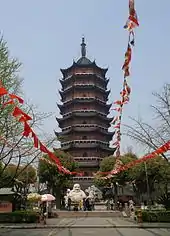
The Qing dynasty converted Nanzhili to "Jiangnan province"; in 1666 Jiangsu and Anhui were split apart as separate provinces. Jiangsu's borders have been for the most part stable since then.
With the start of the Western incursion into China in the 1840s, the rich and mercantile Yangtze river delta was increasingly exposed to Western influence; Shanghai, originally an unremarkable little town of Jiangsu, quickly developed into a metropolis of trade, banking, and cosmopolitanism, and was split out later as an independent municipality. Jiangnan also figures strongly in the Taiping Rebellion (1851 – 1864), a massive and deadly rebellion that attempted to set up a Christian theocracy in China; it started far to the south, in Guangdong province, swept through much of South China, and by 1853, had established Nanjing as its capital, renamed as Tianjing (天京 "Heavenly Capital").
The Republic of China was established in 1912,[16] and China was soon torn apart by warlords. Jiangsu changed hands several times, but in April 1927, Chiang Kai-shek established a government at Nanking; he was soon able to bring most of China under his control. This was however interrupted by the second Sino-Japanese War, which began full-scale in 1937; on December 13, 1937, Nanjing fell, and the combined atrocities of the occupying Japanese for the next three months would come to be known as the Nanjing Massacre. Nanjing was the seat of the collaborationist government of East China under Wang Jingwei, and Jiangsu remained under Japanese occupation until the end of the war in 1945.
After the war, Nanking was once again the capital of the Republic of China, though now the Chinese Civil War had broken out between the Kuomintang government and Communist forces, based further north, mostly in Northeast China. The decisive Huaihai Campaign was fought in northern Jiangsu; it resulted in Kuomintang defeat, and the communists were soon able to cross the Yangtze River and take Nanking. The Kuomintang fled southward and eventually ended up in Taipei, from which the Republic of China government continues to administer Taiwan, Pescadores, and its neighboring islands, though it also continues to claim (technically, at least) Nanjing as its rightful de jure capital.
After the communist takeover, Peking (formerly Peiping, later spelled as Beijing) was made capital of the People's Republic, and Nanjing was demoted to be the provincial capital of Jiangsu. The economic reforms of Deng Xiaoping initially focused on the south coast of China, in Guangdong province, which soon left Jiangsu behind; starting from the 1990s they were applied more evenly to the rest of China. Suzhou and Wuxi, two southern cities of Jiangsu in close proximity to neighboring Shanghai, have since become particularly prosperous, being among the top 10 cities in China in terms of gross domestic product and outstripping the provincial capital of Nanjing. The income disparity between northern and southern Jiangsu however remains large.
Geography
.jpg.webp)
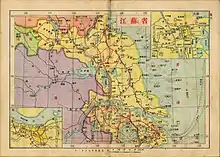
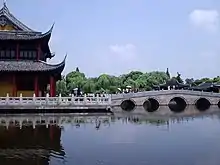
Jiangsu is flat, with plains covering 68 percent of its total area (water covers another 18 percent). Most of the province stands not more than 50 metres (160 ft) above sea level. Jiangsu also has a well-developed irrigation system, which earned it (especially the southern half) the moniker of 水乡 (shuǐxiāng "land of water"). The southern city of Suzhou has so many canals that it has been dubbed "Venice of the East" or the "Venice of the Orient."[17][18] The Grand Canal of China cuts through Jiangsu from north to south, crossing all the east–west river systems. Jiangsu also borders the Yellow Sea. The Yangtze River, the longest river of China, cuts through the province in the south and reaches the East China Sea, which divides the region into two parts: more urban, prosperous south and more poorer, rural north, and these two parts has a tense division.[19] Mount Huaguo, near the city of Lianyungang, is the highest point in Jiangsu, at an altitude of 625 metres (2,051 ft) above sea level. Large lakes in Jiangsu include Lake Tai (the largest), Lake Hongze, Lake Gaoyou, Lake Luoma, and Lake Yangcheng.
Before 1194 A.D., the Huai River cut through north Jiangsu to reach the Yellow Sea. The Huai River is a major river in central China, and it was the traditional border between North China and South China. Since 1194 A.D., the Yellow River further to the north changed its course several times, running into the Huai River in north Jiangsu each time instead of its other usual path northwards into Bohai Bay. The silting caused by the Yellow River was so heavy that after its last episode of "hijacking" the Huai River ended in 1855: the Huai River was no longer able to go through its usual path into the sea. Instead it flooded, pooled up (thereby forming and enlarging Lake Hongze and Lake Gaoyou), and flowed southwards through the Grand Canal into the Yangtze. The old path of the Huai River is now marked by a series of irrigation channels, the most significant of which is the North Jiangsu Main Irrigation Canal (苏北灌溉总渠), which channels a small amount of the water of the Huai River alongside south of its old path into the sea.
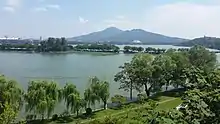
Most of Jiangsu has a humid subtropical climate (Cfa or Cwa in the Köppen climate classification), beginning to transition into a humid continental climate (Köppen Dwa) in the far north. Seasonal changes are clear-cut, with temperatures at an average of −1 to 4 °C (30 to 39 °F) in January and 26 to 29 °C (79 to 84 °F) in July. Rain falls frequently between spring and summer (meiyu), typhoons with rainstorms occur in late summer and early autumn. As with the rest of the coast, tornados are possible. The annual average rainfall is 800 to 1,200 millimetres (31 to 47 in), concentrated mostly in summer during the southeast monsoon.
Major cities:[20]
Administrative divisions
Jiangsu is divided into thirteen prefecture-level divisions, all prefecture-level cities (including a sub-provincial city):
| Administrative divisions of Jiangsu | ||||||||||
|---|---|---|---|---|---|---|---|---|---|---|
| Division code[21] | Division | Area in km2[22] | Population 2020[23] | Seat | Divisions[24] | |||||
| Districts | Counties | CL cities | ||||||||
| 320000 | Jiangsu Province | 102600.00 | 84,748,016 | Nanjing city | 55 | 19 | 21 | |||
| 320100 | Nanjing city | 6582.31 | 9,314,685 | Xuanwu District | 11 | |||||
| 320200 | Wuxi city | 4787.61 | 7,462,135 | Binhu District | 5 | 2 | ||||
| 320300 | Xuzhou city | 11764.88 | 9,083,790 | Yunlong District | 5 | 3 | 2 | |||
| 320400 | Changzhou city | 4384.57 | 5,278,121 | Xinbei District | 5 | 1 | ||||
| 320500 | Suzhou city | 8488.42 | 12,748,262 | Gusu District | 5 | 4 | ||||
| 320600 | Nantong city | 8001.00 | 7,726,635 | Chongchuan District | 3 | 1 | 3 | |||
| 320700 | Lianyungang city | 7615.29 | 4,599,360 | Haizhou District | 3 | 3 | ||||
| 320800 | Huai'an city | 9949.97 | 4,556,230 | Qingjiangpu District | 4 | 3 | ||||
| 320900 | Yancheng city | 16972.42 | 6,709,629 | Tinghu District | 3 | 5 | 1 | |||
| 321000 | Yangzhou city | 6591.21 | 4,559,797 | Hanjiang District | 3 | 1 | 2 | |||
| 321100 | Zhenjiang city | 3840.32 | 3,210,418 | Jingkou District | 3 | 3 | ||||
| 321200 | Taizhou city | 5787.26 | 4,512,762 | Hailing District | 3 | 3 | ||||
| 321300 | Suqian city | 8555.00 | 4,986,192 | Sucheng District | 2 | 3 | ||||
Sub-provincial cities | ||||||||||

| Administrative divisions in Chinese and varieties of romanizations | ||||
|---|---|---|---|---|
| English | Chinese | Pinyin | Wu Romanization | Jiang–Huai (Langjin Pinin) |
| Jiangsu Province | 江苏省 | Jiāngsū Shěng | kaon sou san | Jiang1 su1 Sen3 |
| Nanjing city | 南京市 | Nánjīng Shì | noe cin zy | Lang2 jin1 Shr4 |
| Wuxi city | 无锡市 | Wúxī Shì | vu sih zy | U2 si5 Shr4 |
| Xuzhou city | 徐州市 | Xúzhōu Shì | zi tseu zy | Sü2 zhou1 Shr4 |
| Changzhou city | 常州市 | Chángzhōu Shì | zan tseu zy | Chang2 zhou1 Shr4 |
| Suzhou city | 苏州市 | Sūzhōu Shì | sou tseu zy | Su1 zhou1 Shr4 |
| Nantong city | 南通市 | Nántōng Shì | noe thon zy | Lang2 tong1 Shr4 |
| Lianyungang city | 连云港市 | Liányúngǎng Shì | lie yuin kaon zy | Liän2 üin2 gang3 Shr4 |
| Huai'an city | 淮安市 | Huái'ān Shì | wa oe zy | Huä2 ang1 Shr4 |
| Yancheng city | 盐城市 | Yánchéng Shì | yie zen zy | Iän2 chen2 Shr4 |
| Yangzhou city | 扬州市 | Yángzhōu Shì | yan tseu zy | Iang2 zhou1 Shr4 |
| Zhenjiang city | 镇江市 | Zhènjiāng Shì | tsen kaon zy | Zhen4 jang1 Shr4 |
| Taizhou city | 泰州市 | Tàizhōu Shì | tha tseu zy | Tä4 zhou1 Shr4 |
| Suqian city | 宿迁市 | Sùqiān Shì | soh tshie zy | Su5 ciän1 Shr4 |
These prefecture-level cities are in turn subdivided into 98 county-level divisions (55 districts, 21 county-level cities, and 20 counties). Those are in turn divided into 1,488 township-level divisions (1,078 towns, 122 townships, one ethnic township, and 287 subdistricts). At the end of the year 2017, the total population is 80.29 million.
Urban areas
| Population by urban areas of prefecture & county cities | |||||
|---|---|---|---|---|---|
| # | City | Urban area[25] | District area[25] | City proper[25] | Census date |
| 1 | Nanjing[lower-alpha 1] | 5,827,888 | 7,165,292 | 8,003,744 | 2010-11-01 |
| (1) | Nanjing (new districts)[lower-alpha 1] | 410,298 | 838,452 | see Nanjing | 2010-11-01 |
| 2 | Suzhou [lower-alpha 2] | 3,302,152 | 4,072,081 | 10,459,890 | 2010-11-01 |
| (2) | Suzhou (new district)[lower-alpha 2] | 781,771 | 1,273,880 | see Suzhou | 2010-11-01 |
| 3 | Wuxi | 2,757,736 | 3,543,719 | 6,374,399 | 2010-11-01 |
| 4 | Changzhou[lower-alpha 3] | 2,257,376 | 3,290,918 | 4,592,431 | 2010-11-01 |
| (4) | Changzhou (new district)[lower-alpha 3] | 275,185 | 551,991 | see Changzhou | 2010-11-01 |
| 5 | Xuzhou[lower-alpha 4] | 1,735,166 | 1,967,214 | 8,577,225 | 2010-11-01 |
| (5) | Xuzhou (new district)[lower-alpha 4] | 479,629 | 1,086,564 | see Xuzhou | 2010-11-01 |
| 6 | Nantong | 1,612,385 | 2,274,113 | 7,283,622 | 2010-11-01 |
| 7 | Huai'an[lower-alpha 5] | 1,523,655 | 2,635,406 | 4,801,662 | 2010-11-01 |
| (7) | Huai'an (new district)[lower-alpha 5] | 146,359 | 326,459 | see Huai'an | 2010-11-01 |
| 8 | Yancheng[lower-alpha 6] | 1,136,826 | 1,615,836 | 7,262,200 | 2010-11-01 |
| (8) | Yancheng (new district)[lower-alpha 6] | 347,389 | 706,662 | see Yancheng | 2010-11-01 |
| 9 | Kunshan | 1,118,617 | 1,644,860 | see Suzhou | 2010-11-01 |
| 10 | Yangzhou[lower-alpha 7] | 1,077,531 | 1,392,563 | 4,460,066 | 2010-11-01 |
| (10) | Yangzhou (new district)[lower-alpha 7] | 506,706 | 1,006,372 | see Yangzhou | 2010-11-01 |
| 11 | Jiangyin | 1,013,670 | 1,595,138 | see Wuxi | 2010-11-01 |
| 12 | Zhenjiang | 950,516 | 1,200,760 | 3,114,105 | 2010-11-01 |
| 13 | Changshu | 929,124 | 1,510,453 | see Suzhou | 2010-11-01 |
| 14 | Lianyungang[lower-alpha 8] | 897,393 | 1,050,523 | 4,393,482 | 2010-11-01 |
| (14) | Lianyungang (new district)[lower-alpha 8] | 413,809 | 950,486 | see Lianyungang | 2010-11-01 |
| 15 | Suqian | 783,376 | 1,437,685 | 4,719,178 | 2010-11-01 |
| 16 | Zhangjiagang | 762,625 | 1,246,762 | see Suzhou | 2010-11-01 |
| 17 | Yixing | 710,497 | 1,235,542 | see Wuxi | 2010-11-01 |
| 18 | Taizhou[lower-alpha 9] | 676,877 | 878,463 | 4,618,937 | 2010-11-01 |
| (18) | Taizhou (new district)[lower-alpha 9] | 376,724 | 728,645 | see Taizhou | 2010-11-01 |
| 19 | Pizhou | 631,572 | 1,458,038 | see Xuzhou | 2010-11-01 |
| 20 | Rugao | 614,909 | 1,267,066 | see Nantong | 2010-11-01 |
| 21 | Xinghua | 575,288 | 1,253,548 | see Taizhou | 2010-11-01 |
| 22 | Taixing | 553,079 | 1,073,921 | see Taizhou | 2010-11-01 |
| 23 | Danyang | 500,572 | 960,662 | see Zhenjiang | 2010-11-01 |
| 24 | Dongtai | 489,815 | 990,306 | see Yancheng | 2010-11-01 |
| 25 | Qidong | 479,243 | 972,525 | see Nantong | 2010-11-01 |
| 26 | Haimen | 453,781 | 907,598 | see Nantong | 2010-11-01 |
| 27 | Taicang | 435,225 | 711,854 | see Suzhou | 2010-11-01 |
| (28) | Hai'an[lower-alpha 10] | 424,900 | 866,337 | see Nantong | 2010-11-01 |
| 29 | Xinyi | 402,169 | 920,628 | see Xuzhou | 2010-11-01 |
| 30 | Jingjiang | 388,119 | 684,360 | see Taizhou | 2010-11-01 |
| 31 | Liyang | 368,409 | 749,522 | see Changzhou | 2010-11-01 |
| 32 | Gaoyou | 341,069 | 744,685 | see Yangzhou | 2010-11-01 |
| 33 | Jurong | 299,033 | 617,706 | see Zhenjiang | 2010-11-01 |
| 34 | Yizheng | 271,969 | 564,021 | see Yangzhou | 2010-11-01 |
| 35 | Yangzhong | 179,771 | 334,977 | see Zhenjiang | 2010-11-01 |
- New districts established after census: Lishui (Lishui County), Gaochun (Gaochun County). These new districts not included in the urban area & district area count of the pre-expanded city.
- New district established after census: Wujiang (Wujiang CLC). The new district not included in the urban area & district area count of the pre-expanded city.
- New district established after census: Jintan (Jintan CLC). The new district not included in the urban area & district area count of the pre-expanded city.
- New district established after census: Tongshan (Tongshan County). The new district not included in the urban area & district area count of the pre-expanded city.
- New district established after census: Hongze (Hongze County). The new district not included in the urban area & district area count of the pre-expanded city.
- New district established after census: Dafeng (Dafeng CLC). The new district not included in the urban area & district area count of the pre-expanded city.
- New district established after census: Jiangdu (Jiangdu CLC). The new district not included in the urban area & district area count of the pre-expanded city.
- New district established after census: Ganyu (Ganyu County). The new district not included in the urban area & district area count of the pre-expanded city.
- New district established after census: Jiangyan (Jiangyan CLC). The new district not included in the urban area & district area count of the pre-expanded city.
- Hai'an County is currently known as Hai'an CLC after census.
Most populous cities in Jiangsu Source: China Urban Construction Statistical Yearbook 2018 Urban Population and Urban Temporary Population[26] | |||||||||
|---|---|---|---|---|---|---|---|---|---|
| Rank | Pop. | Rank | Pop. | ||||||
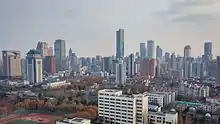 Nanjing  Suzhou |
1 | Nanjing | 6,572,000 | 11 | Taizhou | 967,600 |  Wuxi  Changzhou | ||
| 2 | Suzhou | 3,572,500 | 12 | Zhenjiang | 888,500 | ||||
| 3 | Wuxi | 2,588,400 | 13 | Suqian | 823,900 | ||||
| 4 | Changzhou | 2,340,700 | 14 | Kunshan | 527,400 | ||||
| 5 | Xuzhou | 2,066,900 | 15 | Yixing | 510,400 | ||||
| 6 | Nantong | 1,634,100 | 16 | Changshu | 436,500 | ||||
| 7 | Huai'an | 1,604,500 | 17 | Pizhou | 405,000 | ||||
| 8 | Yancheng | 1,342,700 | 18 | Zhangjiagang | 384,000 | ||||
| 9 | Yangzhou | 1,219,400 | 19 | Jiangyin | 382,500 | ||||
| 10 | Lianyungang | 1,102,000 | 20 | Danyang | 364,400 | ||||
Politics
The politics of Jiangsu is structured in a one party (Communist) government system like all other governing institutions in mainland China.
The Governor of Jiangsu is the highest-ranking official in the People's Government of Jiangsu. However, in the province's dual party-government governing system, the Governor has less power than the Jiangsu Chinese Communist Party Provincial Committee Secretary, colloquially termed the "Jiangsu CCP Party Chief."
Economy

As of 2021, Jiangsu had a gross domestic product (GDP) in nominal of RMB 11.64 trillion (US$1.80 trillion),[27] the second-highest in China after Guangdong. Its GDP is greater than those of South Korea and Russia which are the world's 10th- and 11th-largest economies respectively.[28] Jiangsu's GDP by nominal is greater than the GDPs of all other BRICS states, except India.[29] In 2021, Jiangsu's economy by Purchasing Power Parity reached US$2.83 trillion, making it the 3rd-largest of any country subdivision globally, behind California and Guangdong.[30] Jiangsu's economy in PPP also exceeded that of Italy with a GDP PPP of US$ $2.71 trillion, the 11th largest in the world.[31]
Jiangsu is very wealthy among the provinces of China. Its 2021 nominal GDP per capita reached RMB 137,300 (US$21,287), becoming the first province in China to reach $20,000 mark.[7] Cities like Nanjing, Suzhou, and Wuxi have GDPs per capita around twice the provincial average, making south Jiangsu one of the most prosperous regions in China.
The province has an extensive irrigation system supporting its agriculture, which is based primarily on rice and wheat, followed by maize and sorghum. Main cash crops include cotton, soybeans, peanuts, rapeseed, sesame, ambary hemp, and tea. Other products include peppermint, spearmint, bamboo, medicinal herbs, apples, pears, peaches, loquats, ginkgo. Silkworms form an important part of Jiangsu's agriculture, with the Lake Tai region to the south a major base of silk production in China. Jiangsu is an important producer of freshwater fish and other aquatic products.
Jiangsu has coal, petroleum, and natural gas deposits, but its most significant mineral products are non-metal minerals such as halite (rock salt), sulfur, phosphorus, and marble. The city of Xuzhou is a coal hub of China. The salt mines of Huaiyin have more than 0.4 trillion tonnes of deposits, one of the greatest collections of deposits in China.
Jiangsu is historically oriented toward light industries such as textiles and food industry. Since 1949, Jiangsu has developed heavy industries such as chemical industry and construction materials. Jiangsu's important industries include machinery, electronic, chemicals, and automobile.[32][33] The government has worked hard to promote the solar industry and hoped by 2012 the solar industry would be worth 100 billion RMB.[34] Jiangsu's economy growth has directly benefited from the reform Chinese's policies, and its growth trajectory reflects that of many other coastal provinces, such as Zhejiang and Shandong.[35] The economic reforms of Deng Xiaoping have greatly benefited southern cities, especially Suzhou and Wuxi, which outstrip the provincial capital, Nanjing, in total output. In the eastern outskirts of Suzhou, Singapore has built the Suzhou Industrial Park, a flagship of Sino-Singaporean cooperation and the only industrial park in China that is in its entirety the investment of a single foreign country.
Jiangsu contains over 100 different economic and technological development zones devoted to different types of investments.[36]
Demographics
| Year | Pop. | ±% |
|---|---|---|
| 1912[37] | 32,283,000 | — |
| 1928[38] | 34,126,000 | +5.7% |
| 1936–37[39] | 36,469,000 | +6.9% |
| 1947[40] | 36,080,000 | −1.1% |
| 1954[41] | 41,252,192 | +14.3% |
| 1964[42] | 44,504,608 | +7.9% |
| 1982[43] | 60,521,114 | +36.0% |
| 1990[44] | 67,056,519 | +10.8% |
| 2000[45] | 73,043,577 | +8.9% |
| 2010[46] | 78,659,903 | +7.7% |
| Shanghai was part of Jiangsu Province until 1927. Nanjing part of Jiangsu Province until 1927; dissolved in 1952 and incorporated into Jiangsu Province. | ||
The majority of Jiangsu residents are ethnic Han Chinese. Other minorities include the Hui and the Manchus.
- Demographic indicators in 2000
Population: 74.058 million (urban: 34.637 million; rural: 39.421 million) (2003)
Birth rate: 9.04 per 1000 (2003)
Death rate: 7.03 per 1000 (2003)
Sex ratio: 102.55 males per 100 females
Average family size: 3.25
Han Chinese proportion: 99.64%
Literacy rate: 97.88%
Religion
The predominant religions in Jiangsu are Chinese folk religions, Taoist traditions and Chinese Buddhism. According to surveys conducted in 2007 and 2009, 16.67% of the population believes and is involved in cults of ancestors, while 2.64% of the population identifies as Christian.[47] The reports didn't give figures for other types of religion; 80.69% of the population may be either irreligious or involved in worship of nature deities, Buddhism, Confucianism, Taoism, folk religious sects, and small minorities of Muslims.
In 2010, there are 130,757 Muslims in Jiangsu.[48]
|
Transportation
Jiangsu is home to one of the most extensive transportation networks in China.
Air
Nanjing Lukou International Airport (IATA: NKG) serves as the major airport in the province, with flights to Tokyo, Osaka, Hong Kong, Seoul-Incheon, Frankfurt, Bangkok, Milan, Vancouver and Los Angeles. Other passenger airports include Sunan Shuofang International Airport, Changzhou Benniu Airport, Yangzhou Taizhou International Airport, and Nantong Xingdong Airport. Air traffic in the populated Suzhou area is often diverted to Shanghai Hongqiao International Airport, to which Suzhou is conveniently connected to via bus services and by expressway.
Xuzhou Guanyin International Airport, Yancheng Nanyang International Airport, and Lianyungang Baitabu Airport serve as hubs in northern Jiangsu.
Rail
The southern part of the province, namely the Shanghai-Nanjing corridor, has very high-frequency rail services. Jiangsu is in route of the Jinghu railway from Beijing to Shanghai, as well as the high speed line between the two cities: Shanghai–Nanjing intercity railway and Beijing-Shanghai high-speed railway, completed in 2010 and 2011, respectively. Since the completion of the Beijing-Shanghai high-speed line, travel time between Beijing and Nanjing has been reduced to approximately four hours (from eleven hours previously); travel time between Nanjing and Shanghai on the fastest high-speed trains takes just over an hour.
As of 2022, all major cities in Jiangsu have been connected by high-speed lines, including: Shanghai-Nanjing intercity railway since 2010, Beijing-Shanghai high-speed railway since 2011, Nanjing–Hangzhou high-speed railway since 2013, Nanjing–Anqing intercity railway since 2015, Lianyungang–Zhenjiang high-speed railway since 2020, Xuzhou–Yancheng high-speed railway since 2019, Yancheng–Nantong high-speed railway since 2020, Shanghai–Suzhou–Nantong railway since 2020, and Lianyungang–Xuzhou high-speed railway since 2021.
Road
Jiangsu's road network is one of the most developed in the country.[49] The Beijing–Shanghai Expressway (G2) enters the province from the north and passes through Huai'an, Yangzhou, Taizhou, and Wuxi on the way to Shanghai; travelling from Shanghai westbound, G2 forks at Wuxi and continues onto Nanjing separately as G42, the Shanghai–Nanjing Expressway, which serves the widely travelled southern corridor of the province. The Ningchang Expressway links Nanjing with Changzhou. The Suzhou area is extensively networked with expressways, going in all directions. The Yanhai Expressway links the coastal regions of the province, passing through Nantong, Yancheng, and Lianyungang.
Historically, the province was divided by the Yangtze River into northern and southern regions. The first bridge across the river in Jiangsu, the Nanjing Yangtze River Bridge, was completed in 1968 during the Cultural Revolution. The second bridge crossing, Jiangyin Bridge, opened 30 years later at Jiangyin. As of October 2014, there were 11 cross-Yangtze bridges in the province, including the five in Nanjing, which also has two cross-river tunnels. The Jiangyin Bridge (1,385 m (4,544 ft)), Runyang Bridge (opened in 2005, connecting Yangzhou and Zhenjiang, 1,490 m (4,890 ft)), and Fourth Nanjing Bridge (opened in 2012; 1,418 m (4,652 ft)) all rank among the ten longest suspension bridges in the world. The Sutong Bridge, opened in 2008, connecting Nantong and Changshu, has one of the longest cable-stayed bridge spans in the world, at 1,088 m (3,570 ft).
Metro (subway)
As of October 2022, Jiangsu has five cities that have operational subway systems, together with two extra cities (Nantong and Huai'an) currently under construction. These five cities are Nanjing, Suzhou, Wuxi, Changzhou and Xuzhou.
The Nanjing Metro was opened in September 2005. It was the sixth city in Mainland China that opened up a metro system. As of December 2019 the city currently has 11 metro lines (Line 1, Line 2, Line 3, Line 4, Line 10, Line S1, Line S3, Line S6, Line S7, Line S8 and Line S9), with several extra ones (i.e. Line 5) under construction.
The Suzhou Rail Transit, also known as the Suzhou Metro, was opened in April 2012. As of October, 2022, it currently has five operational lines: Line 1, Line 2, Line 3, Line 4 and Line 5. It also has four other lines under construction (Line 6, Line 7, Line 8, Line S1) and 11 lines under planning (Lines 9, 10, 11 through 16, Line 18, Line 20, Line S4, Line S5). Currently under construction lines are expected to be operational by 2024 and planned lines are expected to be operational by 2035.
The Wuxi Metro was opened in July 2014. The system is currently composed of four operational lines by 2022: Line 1, Line 2, Line 3 and Line 4. It also has two other lines under construction: Line S1 and an extension of Line 4.
The Changzhou Metro was opened in September 2019. The system currently only has two lines operational, Line 1 and Line 2.
The Xuzhou Metro was opened in September 2019, a few days after the Changzhou Metro started operations. The system currently only has three lines operational, Line 1, Line 2 and Line 3.
The Nantong Metro started construction in 2017. It has two lines under construction: Line 1 and Line 2. Line 1 is expected to start operations in 2022.
The Huai'an Metro, also known as the Huai'an Rail System, began construction in November 2018. There are seven lines planned: Line 1, Line 2, Line 3, Line 4, Line 5, Line S1, and Line S2. It is expected to start operations before 2025.
Culture
The four mass migrations in the 4th, 8th, 12th and 14th centuries had been influential in shaping the regional culture of Jiangsu. According to dialects and the other factors, the province can be roughly segmented four major cultural subdivisions: Wu (吴), Jinling (金陵), Huaiyang (淮扬) and Xuhuai (徐淮), from southeast to northwest. The belts of transition blurred the boundaries.[50][51][52]
| Group | Wuyue | Lower Yangtze | Central Plains | |
|---|---|---|---|---|
| Designation | Wu | Jinling | Huaiyang | Xuhuai |
| Major dialect | Wu Chinese | Lower Yangtze Mandarin | Lower Yangtze Mandarin | Central Plains Mandarin |
| Core | Suzhou | Nanjing | Yangzhou | Xuzhou |
.jpg.webp)
Jiangsu is rich in cultural traditions. Kunqu, originating in Kunshan, is one of the most renowned and prestigious forms of Chinese opera.[53] Pingtan, a form of storytelling accompanied by music, is also popular: it can be subdivided into types by origin: Suzhou Pingtan (of Suzhou), Yangzhou Pingtan (of Yangzhou), and Nanjing Pingtan (of Nanjing). Wuxi opera, a form of traditional Chinese opera, is popular in Wuxi, while Huaiju is popular further north, around Yancheng. Jiangsu cuisine is one of the eight great traditions of the cuisine of China.
Suzhou is also well known for its silk, Chinese embroidery, jasmine tea, stone bridges, pagodas, and classical gardens. Nearby Yixing is noted for its teaware while Yangzhou is known for its lacquerware and jadeware. Nanjing's yunjin is a noted type of woven silk.
Since ancient times, south Jiangsu has been famed for its prosperity and opulence, and simply inserting south Jiangsu place names (Suzhou, Yangzhou, etc.) into poetry gave an effect of dreaminess, as was indeed done by many famous poets. In particular, the fame of Suzhou (as well as Hangzhou in neighbouring Zhejiang) has led to the popular saying: 上有天堂,下有蘇杭 ("above there is heaven; below there are Suzhou and Hangzhou"), a saying that continues to be a source of pride for the people of these two still prosperous cities. Similarly, the prosperity of Yangzhou has led poets to dream of: 腰纏十萬貫,騎鶴下揚州 ("with a hundred thousand strings of coins wrapped around its waist, a crane landed in Yangzhou").
Education
Higher education
As of 2022, Jiangsu hosts 168 institutions of higher education, ranking first of all Chinese provinces.[54] There are two Project 985, 11 Project 211, and 16 Double First Class universities in the province. A combination of 93 members of Chinese Academy of Sciences and Chinese Academy of Engineering work in Jiangsu.[55] As of 2020, two major cities in Jiangsu ranked in the world's top 50 (Nanjing 8th and Suzhou 45th) cities by scientific research output, as tracked by the Nature Index.[56]
Double First Class Universities in Jiangsu
| Jiangsu (16) | Nanjing (13) |
|
|---|---|---|
| Wuxi |
| |
| Suzhou |
| |
| Xuzhou |
|
Other Major Research Universities in Jiangsu
- Jiangsu University
- Jiangsu Normal University
- Yangzhou University
- Nanjing Tech University
- Jiangsu University of Science and Technology
- Changzhou University
- Nantong University
- Suzhou University of Science and Technology
- Nanjing Institute of Technology
- Huaiyin Institute of Technology
Additional schools
- Nanjing Jinling High School
- Tianyi middle School
- Xishan Senior High School
- Qianhuang Senior High School
- School of Foreign Languages and Cultures of NNU
Tourism
Nanjing was the capital of several Chinese dynasties and contains a variety of historic sites, such as the Purple Mountain, Purple Mountain Observatory, the Sun Yat-sen Mausoleum, Ming dynasty city wall and gates, Ming Xiaoling Mausoleum (the mausoleum of the first Ming Emperor, Hongwu Emperor), Xuanwu Lake, Jiming Temple, the Nanjing Massacre Memorial, Nanjing Confucius Temple, Nanjing Yangtze River Bridge, and the Nanjing Zoo, along with its circus. Suzhou is renowned for its classical gardens (designated as a UNESCO World Heritage Site), as well as the Hanshan Temple, and Huqiu Tower. Nearby is the water-town of Zhouzhuang, an international tourist destination with Venice-like waterways, bridges and dwellings, which have been preserved over centuries. Yangzhou is known for Slender West Lake. Wuxi is known for being the home of the world's tallest Buddha statue. In the north, Xuzhou is designated as one of China's "eminent historical cities." The official travel and tourism website for Jiangsu[57] was set up in 2008.
- Lion Garden in Suzhou
- Grand Buddha at Ling Shan, Wuxi
- Chaotian Palace
- Qixia Temple
- Tianning Temple Pagoda
- Tombs of Southern Tang Emperor
- Yangzhong Puffer Fish
Sports
.jpg.webp)
Professional sports teams in Jiangsu include:
- China League One
- Kunshan F.C.
- Nanjing City F.C.
- Nantong Zhiyun F.C.
- Suzhou Dongwu F.C.
- China League Two
- Wuxi Wugou F.C.
- Chinese Basketball Association
- Jiangsu Dragons
- Nanjing Monkey King
- Chinese Volleyball League
- Jiangsu Zenith Steel
- China Baseball League
- Jiangsu Pegasus
International relations
Twin Provinces[58]
| Country | State/Province | Time |
|---|---|---|
| Victoria | 1979/11/18 | |
| Aichi | 1980/7/28 | |
| Kangwon | 1984/11/8 | |
| Ontario | 1985/11/21 | |
| New York | 1989/4/21 | |
| Essex | 1992/7/16 | |
| North Rhine-Westphalia | 1992/8/1 | |
| Tuscany | 1992/9/18 | |
| Fukuoka | 1992/11/4 | |
| Punjab | 1993/12/28 | |
| Baden-Württemberg | 1994/4/23 | |
| North Brabant | 1994/9/9 | |
| North Jeolla | 1994/10/27 | |
| Minas Gerais | 1996/3/27 | |
| Veneto | 1998/6/22 | |
| Östergötland | 1999/3/22 | |
| Moscow Oblast | 1999/8/20 | |
| Namur | 2000/5/7 | |
| Free state | 2000/6/7 | |
| Lesser Poland | 2000/11/16 | |
| Southern Finland | 2001/5/11 | |
| Atlántico | 2001/6/4 | |
| Malacca | 2002/9/18 | |
| Alsace | 2007/05/24 | |
| Baja California | 2006/8/23 | |
| Lucerne | 2011/4/26 | |
| California | 2011/7/18 | |
| İzmir | 2012/4/30 | |
| Basque | 2012/4/27 | |
| Capital Region | 2015/1/30 | |
| Mogilev | 2015/5/10 | |
| Khomas | 2015/6/19 | |
See also
- Major national historical and cultural sites in Jiangsu
- Jiangsu-Hong Kong Personnel Training Cooperation Programme
Notes
- The data was collected by the Chinese General Social Survey (CGSS) of 2009 and by the Chinese Spiritual Life Survey (CSLS) of 2007, reported and assembled by Xiuhua Wang (2015)[47] in order to confront the proportion of people identifying with two similar social structures: ① Christian churches, and ② the traditional Chinese religion of the lineage (i. e. people believing and worshipping ancestral deities often organized into lineage "churches" and ancestral shrines). Data for other religions with a significant presence in China (deity cults, Buddhism, Taoism, folk religious sects, Islam, et al.) was not reported by Wang.
- This may include:
- Buddhists;
- Confucians;
- Deity worshippers;
- Taoists;
- Members of folk religious sects;
- Small minorities of Muslims;
- And people not bounded to, nor practicing any, institutional or diffuse religion.
References
Citations
- "Communiqué of the Seventh National Population Census (No. 3)". National Bureau of Statistics of China. 11 May 2021. Retrieved 11 May 2021.
- "2022江苏两会丨"稳"步前行,扛起新使命谱写新篇章". jswx.gov.cn (in Chinese). 2022-01-20. Retrieved 2022-07-20.
- "Sub-national HDI - Subnational HDI - Global Data Lab". globaldatalab.org. Retrieved 2021-12-31.
- "Jiangsu". Lexico UK English Dictionary. Oxford University Press. Archived from the original on May 18, 2021.
- "Jiangsu". Merriam-Webster Dictionary.
- 赵婷婷. "Top 10 regions with highest GDP in China[2]- Chinadaily.com.cn". ChinaDaily.com.cn. Archived from the original on 28 October 2016. Retrieved 22 January 2017.
- "Decoding China's 2021 GDP Growth Rate: A Look at Regional Numbers". China Briefing News. 2022-02-07. Retrieved 2022-09-13.
- "China provinces 'to be bigger than Russia'". FT.com. Archived from the original on 6 April 2012. Retrieved 22 January 2017.
- "GDP (current US$) | 2021 Data". data.worldbank.org. Retrieved 2022-09-13.
- "Jiangsu authorities recount achievements in higher education field over past decade". Jiangsu Provincial Department of Education. September 2, 2022. Retrieved 2022-09-14.
- "ShanghaiRanking's Best Chinese Universities Ranking". www.shanghairanking.com. Retrieved 2022-09-14.
- "Top 200 science cities | Nature Index 2020 Science Cities | Supplements | Nature Index". www.nature.com. Retrieved 2022-11-06.
- (in Chinese) Origin of the Names of China's Provinces Archived 2016-04-27 at the Wayback Machine, People's Daily Online. (in Chinese)
- "Jiangsu - province, China". Britannica.com. Archived from the original on 14 May 2014. Retrieved 22 January 2017.
- 管玉春, 六代繁华帝王都 东晋、南朝的都城——建康 (in Simplified Chinese). 2009-06-24. Archived from the original on 2015-01-04. Retrieved 2015-01-04.
- "Republic of China (1912 AD-1949 AD) - China culture". cultural-china.com. Archived from the original on 18 October 2016. Retrieved 22 January 2017.
- "Suzhou -'Venice in the Orient' – China Travel Guide". Uvista.com. Archived from the original on 2013-05-12. Retrieved 2013-03-26.
- "Nikonians Photo Galleries – Venice of the East". Images.nikonians.org. Archived from the original on 2013-12-06. Retrieved 2013-03-26.
- Jiangsu, New York's China Sister Archived 2018-12-15 at the Wayback Machine, New York Times, 2009-04-27
- "Cities and Towns in Jiangsu". Jiangsu.net. Archived from the original on 5 December 2016. Retrieved 22 January 2017.
- 中华人民共和国县以上行政区划代码 (in Simplified Chinese). Ministry of Civil Affairs. Archived from the original on 2015-04-02. Retrieved 2015-12-11.
- Shenzhen Bureau of Statistics. 《深圳统计年鉴2014》 (in Simplified Chinese). China Statistics Print. Archived from the original on 2015-05-12. Retrieved 2015-05-29.
- "江苏省人民政府 数据发布 江苏省第七次全国人口普查公报(第二号)". www.jiangsu.gov.cn. Retrieved 2022-01-21.
- Ministry of Civil Affairs (August 2014). 《中国民政统计年鉴2014》 (in Simplified Chinese). China Statistics Print. ISBN 978-7-5037-7130-9.
- 中国2010年人口普查分县资料. Compiled by 国务院人口普查办公室 [Department of Population Census of the State Council], 国家统计局人口和社会科技统计司编 [Department of Population and Social Science and Statistics, National Bureau of Statistics]. Beijing: China Statistics Print. 2012. ISBN 978-7-5037-6659-6.
{{cite book}}: CS1 maint: others (link) - Ministry of Housing and Urban-Rural Development of the People's Republic of China(MOHURD) (2019). 中国城市建设统计年鉴2018 [China Urban Construction Statistical Yearbook 2018] (in Chinese). Beijing: China Statistic Publishing House.
- "Decoding China's 2021 GDP Growth Rate: A Look at Regional Numbers". China Briefing News. 2022-02-07. Retrieved 2022-09-13.
- "GDP (current US$) - Korea, Rep., Russian Federation | Data". data.worldbank.org. Retrieved 2022-09-13.
- "GDP (current US$) - Russian Federation, Brazil, South Africa, India | Data". data.worldbank.org. Retrieved 2022-09-13.
- "Global Wealth PPP Distribution: Who Are The Leaders Of The Global Economy? - Full Size". www.visualcapitalist.com. Retrieved 2022-09-13.
- "GDP, PPP (current international $) - Italy | Data". data.worldbank.org. Retrieved 2022-09-14.
- "Jiangsu Province: Economic News and Statistics for Jiangsu's Economy". Thechinaperspective.com. Archived from the original on 2013-05-11. Retrieved 2013-03-26.
- "Country Profile:Jiangsu province -People's Daily Online". English.peopledaily.com.cn. Archived from the original on 2013-05-27. Retrieved 2013-03-26.
- [The China Perspective http://thechinaperspective.com/articles/jiangsusettoreacha100bphotovoltaicindustry6597/index.html Archived 2009-11-19 at the Wayback Machine]
- Wei, Yehua Dennis; Fan, C. Cindy (2010-09-17). "Regional Inequality in China: A Case Study of Jiangsu Province". The Professional Geographer. 52 (3): 455–469. doi:10.1111/0033-0124.00238. S2CID 11030401.
- "Search Results: Economic and Technological Development Zones in Jiangsu". Archived from the original on 2018-12-15. Retrieved 2016-05-10.
- 1912年中国人口. Archived from the original on 24 September 2015. Retrieved 6 March 2014.
- 1928年中国人口. Archived from the original on 24 September 2015. Retrieved 6 March 2014.
- 1936–37年中国人口. Archived from the original on 24 September 2015. Retrieved 6 March 2014.
- 1947年全国人口. Archived from the original on 13 September 2013. Retrieved 6 March 2014.
- 中华人民共和国国家统计局关于第一次全国人口调查登记结果的公报. National Bureau of Statistics of China. Archived from the original on 2009-08-05.
- 第二次全国人口普查结果的几项主要统计数字. National Bureau of Statistics of China. Archived from the original on 2012-09-14.
- 中华人民共和国国家统计局关于一九八二年人口普查主要数字的公报. National Bureau of Statistics of China. Archived from the original on 2012-05-10.
- 中华人民共和国国家统计局关于一九九〇年人口普查主要数据的公报. National Bureau of Statistics of China. Archived from the original on 2012-06-19.
- 现将2000年第五次全国人口普查快速汇总的人口地区分布数据公布如下. National Bureau of Statistics of China. Archived from the original on 2012-08-29.
- "Communiqué of the National Bureau of Statistics of People's Republic of China on Major Figures of the 2010 Population Census". National Bureau of Statistics of China. Archived from the original on 2013-07-27.
- China General Social Survey 2009, Chinese Spiritual Life Survey (CSLS) 2007. Report by: Xiuhua Wang (2015, p. 15) Archived 2015-09-25 at the Wayback Machine
- "Muslim in China, Muslim Population & Distribution & Minority in China". topchinatravel.com. Retrieved 2021-08-16.
- "Jiangsu Chamber of International Commerce". coicjs.org. Archived from the original on 17 April 2016. Retrieved 22 January 2017.
- 江苏省地方志 文化. jssdfz.jiangsu.gov.cn. Archived from the original on 2017-12-31. Retrieved 2017-12-31.
- "Jiangsu Provincial Geography" (in Chinese). Beijing: Beijing Normal University Publishing Group. 2011. ISBN 9787303131686.
- 江苏省2001-2010年文化大省建设规划纲要 淮安宣传网-中共淮安市委宣传部主办. xcb.huaian.gov.cn. Huai'an People's Government. Archived from the original on 2017-12-31. Retrieved 2017-12-31.
- Luxembourg, China Collection -. "China Collection: Online Gallery - Discover Asia - Geography, Provinces, 4". www.china-art-collection.com. Archived from the original on 2018-02-28. Retrieved 2018-02-28.
- ""List of National Colleges and Universities - Government Portal of the Ministry of Education of the People's Republic of China"". www.moe.gov.cn. Retrieved 2022-08-07.
- 2015年江苏省国民经济和社会发展统计公报. Jiangsu Bureau of Statistics. Archived from the original on 2016-11-28. Retrieved 2016-11-27.
- "Top 200 science cities | Nature Index 2020 Science Cities | Supplements | Nature Index". www.nature.com. Retrieved 2022-11-06.
- "official travel and tourism website for Jiangsu". Archived from the original on 2010-01-03. Retrieved 2010-01-29.
- "江苏省外事办 友城风采 省级友城统计表(截止2016年9月,共32对)".
- "江苏省外事办 友城风采 市县友城统计表(截止2016年9月,共268对)".
- ベルギー3地域と「友好交流及び相互協力に関する覚書」を締結. Archived from the original on 28 August 2017. Retrieved 15 May 2017.
Sources
- Economic profile for Jiangsu at HKTDC
External links
- Jiangsu Government website (in Chinese)
- Jiangsu Government website (in English)
- Complete Map of the Seven Coastal Provinces from 1821 to 1850 (in English and Chinese)
